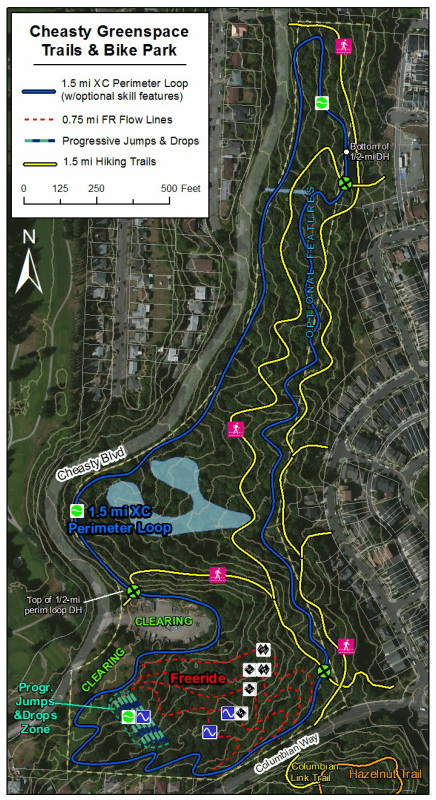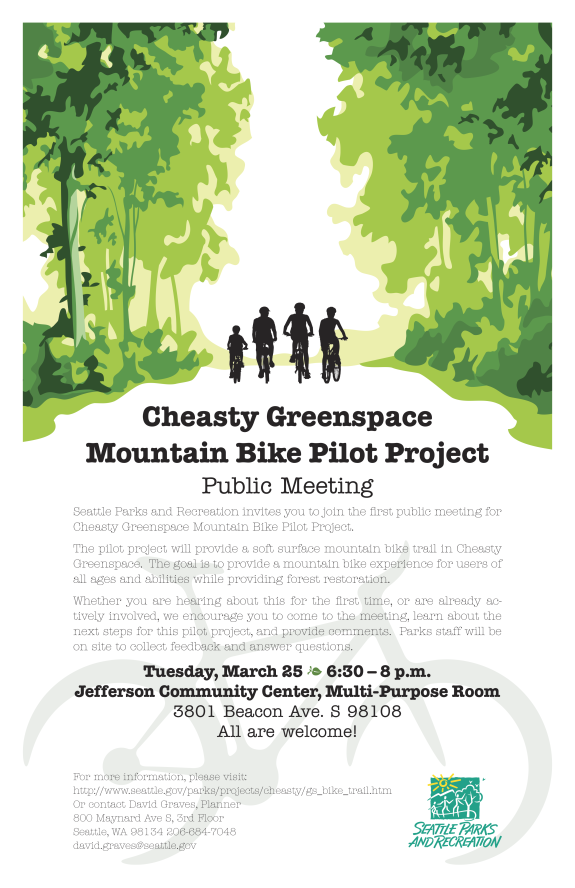
Tuesday is shaping up to be quite a packed bike meeting day. The Safe Roads Awareness Week kickoff walk is in the afternoon, then an open house for the second Ballard neighborhood greenway is in the evening. But if mountain biking is your passion, you may want to attend the Cheasty Greenspace Mountain Bike Pilot Project meeting on Beacon Hill.
The meeting is Tuesday, 6:30 – 8 p.m. at Jefferson Community Center.
As we reported previously, the Cheasty project (once known as the “Beacon Bike Park”) received approval from the Parks Department to move forward as a pilot project to test the concept of having mountain bike trails in an urban forest. While Seattle does have the I-5 Colonnade mountain bike park in Eastlake, the Cheasty Greenspace is different. It’s a steep green area in a part of the city with few other forested areas (on border of Beacon Hill and Rainier Valley).
However, the Cheasty forest has some fairly intense issues with invasive plant species, and has long had issues with dumping and littering (the Cheasty MTB group has more information on their website). There are also few usable trails through the area for people on foot or bike, making it difficult for residents to access the woods.
Some neighbors see the lack of human foot or bike traffic as a good thing for preserving wildlife habitats, but others see it as a missed opportunity for neighbors with few hiking and mountain biking opportunities nearby. The proximity to Bike Works, for example, creates an excellent opportunity for their youth programs. It’s no secret that kids love mountain biking, but not everyone has easy access to a car to drive to mountain bike parks around the region.
Following the lead set by Evergreen MTB in other natural areas, the Cheasty group plans to help clean, restore and maintain the area. The energy behind mountain biking could brings a big volunteer pool to the park.
These arguments (and likely more) will be partly hashed out at the Tuesday meeting. More details:









Comments
3 responses to “Mountain biking in an urban forest? Cheasty MTB Park public meeting Tuesday”
First off, a big thanks to this blog, because I never would have heard about the Cheasty issue, except for your coverage (back in Jan, 2014).
I recently wrote a post that tried to sketch out the basics of why some others and I think this is a very bad idea: http://ahlness.wordpress.com/2014/03/13/a-tale-of-two-cheasties/ My points barely touch the surface of the issues.
The post has been viewed over a thousand times in the last 10 days – by both sides. As you said, this is a hot issue. There have been many comments on that post. I’ve started moderating them because a few pro mountain biking folks have been less than polite (that’s putting it mildly) in their feedback to me. It is indeed a contentious issue.
Last, I will say two things:
1) I do not live in the neighborhood, so those who have called me a nimby are out of luck, but I do live and pay taxes (some of which bought Cheasty as a Natural Area) in Seattle. Cheasty Greenspace belongs to ALL of Seattle’s citizens, not just the neighbors, and not just the mountain bike riders.
2) I am a bike rider. Now a retired teacher, I rode my bike to work every day for the last 15 years. I used to be proud to be a bike rider.
I hope many come to the meeting on the 25th.
This is not about keeping people out, as you suggest. It’s simple: Cheasty is too small to accommodate both a specialized user-group, plus the general population, and still have anything left over for wildlife habitat. The intensity of use would far exceed the carrying capacity of the land. Anyone who has witnessed what 10 or 20 years of intense use does to a natural area knows this well.
Plus, Seattle has already developed or landscaped 86% of its park land. Only 14% remains natural (source: Seattle Times, 3/5/11). These parcels should not be allotted to specialized user-groups—they should be reserved for the general population, as well as wildlife. It is the traditional policy for natural areas, and it should not be changed now. Especially now—as we face the uncertainties of climate change.
It is troubling that the city seems to be allotting this parcel in return for eco-restoration services. What kind of message does this send to all the stewards and volunteers that have been working for years and have never asked for anything in return? Volunteerism will become a quid-pro-quo system that doles out access to nature based on ability to pay—favoring specialized groups over the general population. Who will advocate for the low-income, the less-abled, elderly? What about their access to nature?
The city needs to take responsibility and fund eco-restoration where it’s needed, and permanently protect what little nature is left—reserved for the general population and for wildlife. We don’t have enough natural areas left to accommodate specialized user-groups.
Natural areas should be reserved for nature.
Everyone loves “wildlife” until it’s Norweign tree rats, racoons, coyotes and feral cats. Then it’s please get this stuff under control. A small park will have only varmits and birds (I love birds… but not rats, racoons or coyotes.) Then it gets homeless campers.
Having bike trails will make the park less friendly to homeless campers. While they are still people, and deserve a safe place to sleep, I’d prefer them not to camp in city parks.